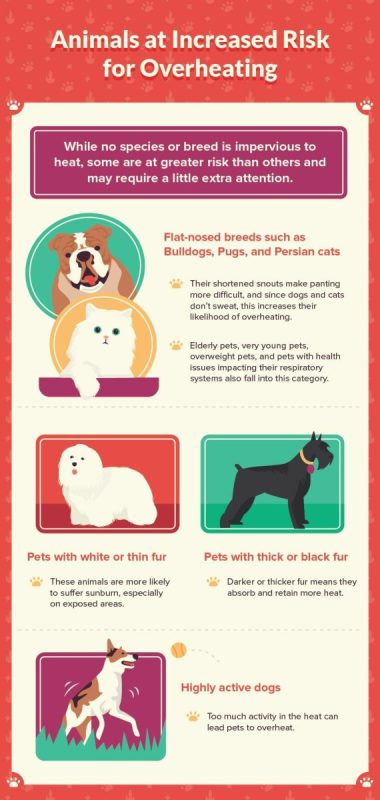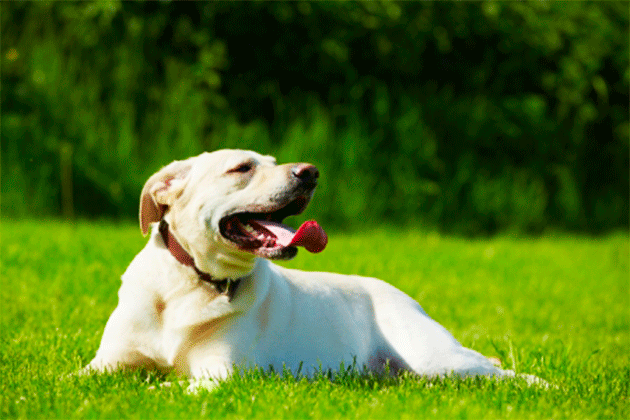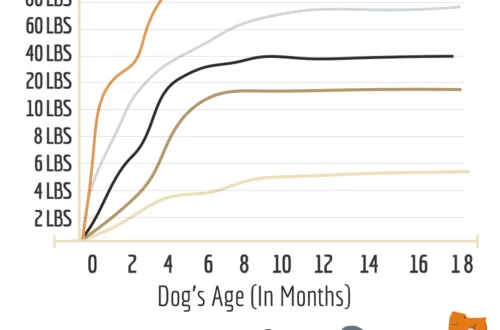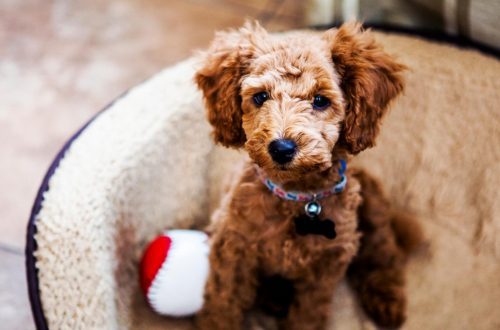
Heat stroke and sunburn in dogs and cats

Summer is not only a time of fun walks, hikes, travels and swimming in ponds, but also high temperatures and the scorching sun. What can happen to a pet in hot weather?
Contents
Heat and sunstroke
Heat stroke occurs when the overall body temperature rises (40,5-43,0ºС) at a high ambient temperature. It can develop in animals that are outside for a long time (even in the shade) in hot weather, on a closed balcony, loggia, greenhouse, or in an overheated car. Even cats that love and take sunbaths, and lie in the sun itself, can overheat, and still not go into the shade. Sunstroke is also a type of overheating, but it occurs with prolonged exposure to the sun and as a result of exposure to direct sunlight on the body.
What increases the risk of heat stroke?
- The specific structure of the skull of brachycephalic breeds of dogs and cats (pug, bulldog, boxer, griffon, petit-brabancon, pekingese, british, persian and exotic cat)
- Messy, tangled, uncombed coat and dirty skin
- Lack of freely available water
- Hot and humid weather
- Age (too young or old)
- Infectious diseases
- Heart Disease
- Diseases of the respiratory tract
- Skin diseases
- Obesity
- Inability to leave a hot place
- Tight ammunition and tight deaf muzzles
- Physical activity in hot weather
- Moving from cold climates and hotter
- Dark colored wool that heats up quickly in direct sunlight
How can you tell if your pet is overheated?
- Temperature increase
- Rapid breathing and heartbeat
- Red tongue and oral mucosa
- glazed look
- Lethargy, drowsiness
- Weak response to stimuli
- Impaired coordination
- Hypersalivation, nausea and vomiting, diarrhea
- Loss of consciousness
- With an even greater increase in temperature, the mucous membranes become pale or cyanotic, convulsions, wheezing breathing are observed, the animal may fall into a coma and even die.
What to do?
First of all, start cooling the animal: place it in the shade, apply wet towels or ice packs on the stomach, neck and paw pads, you can moisten the coat with water and direct a fan or a cold hair dryer at the pet. Offer cool water to drink. Measure temperature rectally every 10 minutes. If the animal loses consciousness, coordination is disturbed, the temperature does not decrease, take it to the veterinarian immediately.
Solar burns
The coat and natural pigment of the skin protect against exposure to sunlight, but, nevertheless, the animal can still get burned if it has a white color, a light nose color, unpigmented eyelids, thin sparse or very short hair, does not have it by breed or by other reasons – alopecia, skin diseases or shaving baldly, as well as animals with albinism are very susceptible to ultraviolet radiation. The sensitive skin of the nose and the area around it, the tips of the ears and the bare abdomen are especially easily sunburnt. In the most severe cases, skin cancer can develop with constant intense exposure to ultraviolet radiation. Predisposed to sunburn (solar dermatitis) are cats – various sphinxes and lycoys, dogs of the xoloitzcuintle breeds, hairless terriers, staffordshire terriers, fox terriers, bulldogs, bull terriers, weimaraners, dalmatians, boxers, smooth-haired greyhounds, chinese crested, kurtshaars and russian toys.
Torso burn
Most often, the stomach, inguinal region, and the tip of the tail suffer. Damaged skin turns red, peels off, a red rash, blisters and crusts appear. Burned skin is painful, and a bacterial infection may follow. At the same time, not only dogs, who often walk in the fresh air, but also cats, who are ready to endlessly fry on the windowsill in direct sunlight, easily get burns.
Nose and ear burn
Sunburned areas turn red, hair falls out, skin is painful, flaky and crusty. The ears are cracked at the edges, bleeding, sometimes even bent, very sensitive.
- In extreme cases, when a large area of the body has been affected, a painful burn shock may even develop: the skin is cold, the mucous membranes are pale, consciousness is confused or absent, impaired coordination and vision. In this case, you must immediately take the animal to the veterinarian.
Paw pad burns on hot surfaces
In summer, asphalt and tiles get very hot in the sun, and a pet can get burned very quickly! When in contact with this surface, animals get burns to the paw pads, while painful sensations, swelling, blisters and crusts appear. Constant contact of damaged paw pads with surfaces does not allow the burn to fully heal, the wound is easily infected.
What to do?
Painful sensations with mild burns can be relieved by cooling the damaged areas with cool (not cold!) Compresses, or simply by spraying from a spray bottle. Panthenol spray may be suitable for skin repair with minor burns. For paw burns, for healing and protection against infection, you can use Levomekol, Ranosan ointment and powder and Sangel ointment, as well as bandage the paw and, until it heals, take a walk in a protective boot. If the burn is stronger than simple redness and peeling of the skin, blisters, ulcers, cracks form, the skin comes off – you should not self-medicate, you should contact your veterinarian.
How to protect a pet?
- Provide shade.
- Clean water must be available at all times.
- Use roller blinds and blinds that will keep the cat from lying in the scorching sun.
- Combing – clean and combed wool is better breathable.
- It is better to move physical activity and walks to the early morning and evening hours, when there is no heat, avoid going out from 11:00 to 16:00, during the period of the highest activity of the sun.
- At home, the animal may like to sleep on the tiles, you can also purchase a special cooling mat for it.
- Pool located in the shade on the site.
- Frozen treats in special hollow toys, so you can fill the toy with berries, fruits, food pieces, cottage cheese and freeze it.
- Use of cooling dog blankets or bandanas.
- The use of light, light, not tight and breathable clothing – T-shirts, T-shirts, dresses, and hats – special visors, caps, panama hats.
- Albino dogs also wear sunglasses to protect their very sensitive eyes, but any other breed can wear them as well.
- It is permissible to use children’s sunscreens, having previously checked on a small area of the body for allergies and paying attention to the composition, whether it contains substances harmful and dangerous to animals – methylparaben, benzophenone-3 / oxybenzone, formalin, triethanolamine.
- Walk in the shade, choose areas for walking where there is no asphalt hot in the sun – on grass, on the ground. If you still have to walk on hot surfaces, you can use breathable dog shoes.
- When walking, always take a bottle of water and give your pet a drink.





